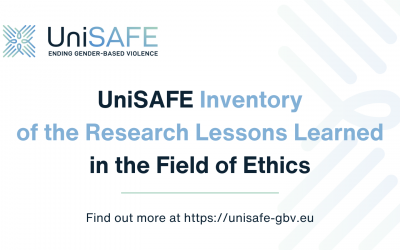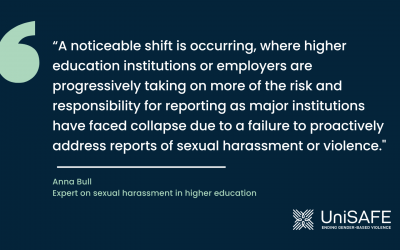Despite the growing awareness around the issue of violence against women, reliable and harmonised data on the prevalence of gender-based violence in European countries is still hard to find. Such data becomes even more scarce in relatively under-researched contexts such as the workplace, particularly in universities and research organisations.
Gender-based violence in the workplace is still under-researched
To date, gender-based violence has predominantly been explored in the household context, in the form of domestic violence or intimate partner violence. The Eurobarometer study of data from 2016 showed that the vast majority of the population in Europe perceived the household as the main context in which gender-based violence may arise. Indeed, according to the survey, 86% of Europeans believed that violence against women is more likely to occur at home.
Only 17% of the respondents to the survey mentioned the workplace as a context in which gender-based violence is likely to occur, and fewer still — only 5% of respondents — identified universities as problematic. The aftermath of the #MeToo movement in its various forms has brought gender-based violence under the spotlight in many countries, and some cases received in-depth coverage from the media. Yet, despite the growing attention from the media, the general public doesn’t seem to perceive the workplace and universities in particular as problematic.
Perhaps reflective of this perception is the relatively little attention that research projects have dedicated to gender-based violence in the working environment. The extent to which this perception matches the actual size of the phenomenon is still unexplored.
Anecdotal evidence and cases reported by the media suggest that we might underestimate the prevalence of gender-based violence in universities and research organisations.
Extensive mapping showed the need for data on gender-based violence in research organisations
How can we gain reliable data on this under-researched issue?
To produce a solid knowledge base for more informed policy making, UniSAFE has carried out a mapping of quantitative studies and thorough country reviews by national experts.
The mapping showed that very few studies focused on the prevalence of gender-based violence in research organisations at the national level. Most importantly, none of those studies covered the prevalence of all the forms of gender-based violence encompassed in UniSAFE’s definition.
Only one study, for instance, focused on online violence. Sexual harassment, like many other forms of gender-based violence, is increasingly taking place online, facilitated by the digitalisation and the COVID-19 pandemic. Research has shown that these new forms of violence are increasing at an alarmingly fast rate. While both women and men are at risk of online violence, women experience a much greater risk, and perpetrators are predominantly male. It seemed thus crucial to account for these new forms of violence in our research.
Moreover, our mapping found very few studies that included both staff and students in their research, and none of them was keeping track of economic or organisational violence. These forms of violence, well-known and researched in the context of intimate partner violence, are much less studied in the context of research organisations.
Finally, the studies were predominantly victims-focused, rather than targeting bystanders or perpetrators.
UniSAFE will address this gap in research by gathering evidence on all these forms of gender-based violence, including emerging forms of violence, and their prevalence in research organisations. Moreover, our project seeks to broaden the understanding of gender-based violence in the workplace by including forms of violence that are experienced as abuse, but may not be conventionally understood as gender-based violence yet.
UniSAFE will also bear in mind the importance of intersectionality: people who are located at the intersection of multiple inequalities are much more likely to experience gender-based violence. Women on temporary contracts or early-career researchers, and those who have less secure employment conditions, are more likely to experience multiple forms of violence – spanning from sexual harassment to economic violence, coercion, mobbing and bullying in the workplace.
UniSAFE’ contribution to establishing a knowledge base
Our mapping has outlined the research gap on gender-based violence in universities and research organisations. UniSAFE will address this gap by analysing all forms of gender-based violence, including emerging forms, in European universities and organisations. The first step will be collecting quantitative evidence from 45 research organisations in 15 countries, and investigating organisational responses and infrastructure through in-depth case studies, interviews, and strategic mapping of research organisations’ policies.



